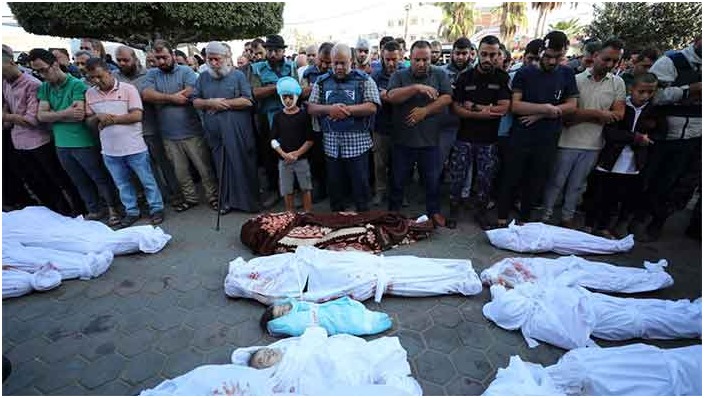RIGHTEOUS HATE RETURN TO INDIA
0 comments | by Pankash Mishra

Exactly 30 years ago this month, lynch mobs led by politicians slaughtered almost 3,000 kSihs in Delhi, in some cases by hanging burning tires around their necks. The pogrom came as retaliation to the assassination of Prime Minister Indira Gandhi by her Sikh bodyguards. In nationwide elections held a few weeks later, the Congress party, some of whose members had helped supervise the killings, won in a landslide.
With state elections approaching, parts of Delhi are again awash with manufactured hate. The Trilokpuri neighborhood, which witnessed the deaths of hundreds of Sikhs in 1984, recently suffered clashes between Hindus and Muslims, as well as a brutal police crackdown on the minority community.
A resurgence of communal violence and hatred elsewhere in the country also recalls the largely unpunished crimes of 1984 and their bitter lessons: how mass murderers can be rewarded with huge electoral victories and high political office, and how the judicial system can be gamed in full view of a largely acquiescent if not craven media.
In an exceptionally insightful article in the Economic and Political Weekly, the historian Dilip Simeon argues that “the year 1984 set a new standard for the normalisation of brutality and lawlessness” in India. Today many Indians “do not believe that involvement in mass crimes should disqualify anyone from holding executive power. They distinguish ‘development’ from justice, forgetting that ‘development’ without secular norms and lawful governance will lead to tyranny.”
Simeon sees the Congress’s cynical use of violence in 1984 as a “force-multiplier” for the Hindu nationalist Bharatiya Janata Party, whose religious-political campaigns in the early 1990s led to thousands of deaths. The anti-Muslim pogrom in Gujarat in 2002 resuscitated the BJP in the state and set the stage for Narendra Modi’s subsequent ascent to the summit of power in Delhi.
There is one important difference, however. Divide-and-rule is now more than an opportunistic electoral gambit: The extended family of Hindu nationalists seems to be looking past election victories in hopes of drastically remaking India’s social and political landscape. Their aim is to consolidate a permanent Hindu majority against such real and imagined aliens as Muslims, Christians, liberals, communists, secularists, Western NGOs and independent-minded women.
During this year’s election campaign, Modi attacked the incumbent Congress government for allegedly killing rhinoceroses to clear land in India’s northeast for Bangladeshi Muslim settlers. As prime minister now, exposed to the full glare of international scrutiny, Modi leaves it to his supporters to elaborate on the potent theme of insidious internal and external enemies.
One of their favored memes is the “love jihad” -- the term recently employed by a BJP legislator to accuse Muslims of Islamicizing India by impregnating Hindu women. As the writer Sonia Faleirowrote last month in the New York Times, “consenting adults who have broken no laws have been threatened, beaten up and, in a medieval twist, had their faces painted black by pumped-up bands of roving men.”
Hindu vigilantes, who have long assaulted supposedly immoral women and burned books and paintings, enjoy a new respectability and influence. The books of Dinanath Batra, who led the campaign to pulp Wendy Doniger’s “The Hindus,” have been made compulsory reading in Gujarat’s schools, while distinguished historian Romila Thapar, who authored the “Penguin History of Early India,” is abused as a “sickular commie” by mainstream commentators no less than online stalkers. The head of the Hindu nationalist Rashtriya Swayamsevak Sangh, which has been proscribed twice in independent India for fomenting violence, was given a prime time slot on state television to rant against Muslim infiltrators.
Indeed, a senior BJP leader appealed last month, at Delhi’s prestigious National Museum no less, for a public bonfire of canonical history books. He had previously urged that Muslims be stripped of voting rights until they acknowledge their Hindu ancestry. Both proposals were resoundingly supported by his nearly one million followers on Twitter.
Neo-Hindu tweeters and bloggers who command virtual lynch mobs on social media best embody the nihilist ethos that everything is permitted. India’s public (or at least its online) life suddenly seems dominated by people Simeon bluntly describes as “sociopaths and criminally insane persons … whose lust for power poisons the very air we breathe.”
Out of despair, Simeon invests his faith in political leaders who “ought not to reinforce popular prejudice, but should speak reasonably to calm passions.” Modi, however, shows no signs of moving toward a Sistah Souljah moment. Three decades after India witnessed the carnage provoked by unchecked communal demagoguery, there seem to be fewer and fewer political or ethical constraints on Indians who are drunk on righteous hate.





